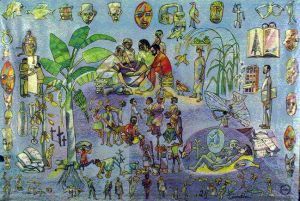| Jesuit
missions during the sixteenth century in India, Indonesia, Japan,
and China. |
 |
|
Christian
art from India
|
In 1542 the Spaniard
Francis Xavier, one of the original band of Jesuits,
arrived in Goa on the Indian subcontinent and made this site his missionary
headquarters. From here he evangelized Indonesia and then went on to
Japan where he arrived in 1549. Xavier pioneered what would later become
a typical Jesuit approach in mission by appealing to politically and
culturally influential leaders. In Japan Francis led in the formation
of a small church which would thereafter endure centuries of tribulation
and persecution. Xavier himself died in 1572 on an island off the Chinese
coast without having accomplished his purpose of evangelizing China.
An Italian Jesuit, Matteo Ricci, entered China in 1583 and after encountering
many difficulties made his way in 1601 to the capital, Beijing, where
he remained until his death. Here he won the respect of the Chinese
through the use of his scientific knowledge, cartography, and his ability
to explain the workings of clocks. Ricci pioneered an approach to missions
which urged the adaptation of Christian faith and practice to the context
where possible. He argued, for example, that certain elements of Confucian
observance might be theologically and liturgically adapted by Christians
without compromise of their faith. This led to a prolonged controversy
over Jesuit methods in China which resulted in censure by the pope.
A public Christian presence continued in China until 1724 when Christianity
was proscribed and began an underground existence which lasted until
the opening of China to the West in the nineteenth century.
|
